|
9:30~10:00 |
受付 |
|
10:00~10:45 |
基調講演 Michel LORRILLARD (EFEO in Vientiane, History) 仏教王権の確立と文書・刻文について |
|
|
Scripts and History: the case of the Lao Kingdom of Lan Xang
Michel LORRILLARD
EFEO in Vientiane
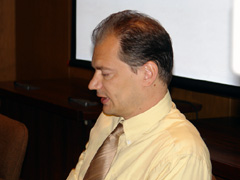 This paper traces the diffusion of Lao scripts by taking stock of the oldest inscriptions found in Laos. Their different styles and methods of writing are analysed and compared to other Tai scripts. The results show that the appearance of scripts in Laos is closely related to the diffusion of Lan Na Culture and Buddhism. Now that there is a substantial inventory of lao inscriptions, it is possible to recognise the ways both secular and religious writings spread into the territory of the former Kingdom of Lan Xang, and to understand the processes that led to their actual formation.
|
 session 3:呪術・宗教と読み書き session 3:呪術・宗教と読み書き
司会:馬場雄司(三重県立看護大学・教授)
|
|
10:45~11:15 |
津村文彦(福井県立大学・専任講師) |
|
|
Tham scripts and Bailan in a modern Isan Village
TSUMURA Fumihiko
Fukui Prefectural University
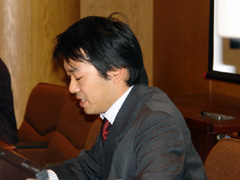 This presentation focuses on the modern use of palm leaf books, bailan, and Tham scripts in the rural life of the Northeastern Thailand, from an anthropological viewpoint. The studies of these old scripts, referred to as akson boran, were undertaken in Thailand in the fields of history or literature. However, most villagers use the palm leaves and old scripts merely as "tools," consciously or unconsciously misreading and misinterpreting their literal meanings. Therefore, I attempt to analyze the knowledge contained in the bailan and Tham scripts as a tool for understanding the bodiness and religious consciousness of the villagers. The usefulness of this knowledge is not limited to only the village intellectuals, such as the monks, but also in a general sense, to the villagers. This study aims to shed light on the knowledge surrounding bailan and Tham scripts, which is related to the bodiness and religious beliefs, in the various contexts of the village.
After an introduction to the modern history of the post-19th century scripts, I examine the data related to the bailan and Tham scripts in some villages of Northeastern Thailand. Some monks and ritual practitioners in these villages are able to read and write such old scripts; however, the extent of their knowledge and use varies. The interest in old scripts appears to be decreasing in these villages, although some villagers are becoming increasingly interested in them, particularly in the herbal descriptions provided in the bailan and in local knowledge, which is useful for regional promotion and motivated by political concerns. The old scripts are not only read or written in static language but are also used as tools at various levels and have the potential to connect traditional bodiness with regional consciousness.
Fumihiko TSUMURA, is a lecturer at Center for Arts and Sciences of Fukui Prefectural University. His research deals with the local knowledge in the contexts of modern rural village in Northeastern Thailand. He is currently working of the issues of spirit cults, herbal medicine, and the demarcation between science and magic in rural contexts. His publications include "Anthropological Study of Traditional Script and Knowledge in Northeastern Thailand" (2002) The Journal of Thai Studies no.2, Osaka: The Japanese Society of Thai Studies. [in Japanese] and "'Modern' Mode of 'Traditional' Herbal Practitioner in Northeast Thailand" (2005) Journal of Fukui Prefectural University no.26, Fukui: Fukui Prefectural University. [in Japanese].
|
|
11:15~11:45 |
Peter KORET (EFEO in Vientiane, Literature) |
|
|
The Magic of Writing in Traditional Lao Literature
Peter KORET
Ecole française d'Extrême-Orient
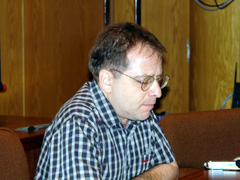 My paper is a study of the cultural context of writing and literary scripts in traditional Lao literature. It examines how both intentionally and unintentionally the written medium has served to shape an audience's perception of both individual literary works and the very concept of literature itself. A major focus of this study is the investigation of the close relationship between the written medium of the literature and its status as a 'sacred Buddhist' and 'supernatural' tradition.
Peter Koret is currently working in Laos on a research project involving Lao Buddhist Millenarian literature. He has worked as a visiting assistant professor at the University of California Berkeley, teaching courses on Buddhism and culture in Southeast Asia, and literature at Arizona State University. His major research lies in the traditional literature of the Lao. Publications include 'The Invention of Lao Literature as an Academic Subject of Study' in Laos: Culture and Society, edited by Grant Evans Books of Search: 'Convention and Creativity in Lao Literature' in 'The Literary Canon in Southeast Asia', edited by David Smith, and a forthcoming book on the Lao Poem Leup Phasun and its twentieth century interpretation.
|
|
11:45~12:00 |
コメンテータ:飯島明子(天理大学国際文化学部・教授) |
|
|
IIJIMA Akiko
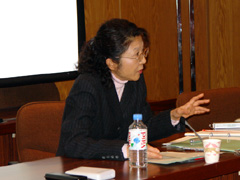
(1) Professor, Faculty of International Culture Studies, Tenri University
(2) Social and cultural histories in northern mainland Southeast Asia with a particular focus on history of Tai peoples
(3) Recent Publications:
2003 The Nyuan in Xayabury and Cross-Border Links to Nan, Christopher E. Goscha and Soren Ivarsson (ed.), Contesting Visions of the Lao Past, Copenhagen: NIAS Press, pp. 165-180. [in English]
2003 The Manuscripts Culture in Muang Sing, Laos, Institute of Cultural Researches of Laos, Ministry of Information and Culture, Lao P.D.R. (ed), Introduction to Lao Studies, Tokyo: Mekong Publisher, pp. 493-520. [in Japanese]
|
|
12:00~12:30 |
質疑応答 |
|
12:30~14:00 |
昼食 |
 session 4:文字・文書継承と社会集団 session 4:文字・文書継承と社会集団
司会:村上忠良(大阪外国語大学・助教授)
|
|
14:00~14:30 |
吉野晃(東京学芸大学・教授) |
|
|
The functions of Chinese literacy in the Iu Mien society of Northern Thailand
YOSHINO Akira
Tokyo Gakugei University
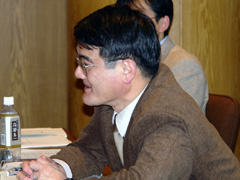 The Iu Mien society accepted the Chinese writing system and has since used the system for preparing its ritual and secular documents. The Iu Mien priests chant verses from their sacred book that is written in Chinese and also write their prayers in Chinese. In the past, contractual agreements between parties were also prepared in Chinese
Chinese literacy has continued among the members of the Iu Mien community in China and Southeast Asia for a long time. In the past, they often hired Han Chinese teachers to teach their boys to read and write in Chinese. This educational arrangement was the same as that of a temporary private school. This form of teaching has also been accepted in China, Laos and Thailand.
The ability to read and write in Chinese was regarded as one of the standards of social status in the Iu Mien society. At present, due to the spread of school education in the highlands of Thailand and also because very few boys learn Chinese in reality, Chinese literacy no longer functions as a standard for determining the social status in the Iu Mien society in Thailand. However, it functions as an ethnic symbol of the Iu Mien in Thailand. This tendency is observed in certain Iu Mien cultural education projects in Thailand, in which the instruction of reading and writing Chinese is the first course for imparting knowledge on the Iu Mien culture.
YOSHINO Akira is a professor of social anthropology at Tokyo Gakugei University. He has mainly researched the social organisation, ethnicity, ancestor worship and the ecological adaptation of the Iu Mien of Northern Thailand for nineteen years. He has also conducted his fieldwork on the ethnic identity of the Iu Mien in Guangdong and Guangxi in China. In recent years, his research has focused on labour migration and the increase of nuclear family households in the Iu Mien society.
|
|
14:30~15:00 |
新江利彦(東京外国語大学大学院地域文化研究科・COE研究員) |
|
|
The symbolic role of the literacy as a standard to distinguish the Raglai from the Cham in Vietnam
SHINE Toshihiko
Tokyo University of Foreign Studies
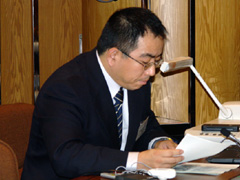 The Raglai, Churu, and Hroi and most Malay speakers of the Montagnards [Vietnam's Central Highlanders] have the same language, folklore, culture, and pantheon with the Cham. The Raglai people don't really have a history of literature. In their tradition the Cham teach their writing under the master-pupil system through their Ahier and Awar specialist, religious, 'priest' groups. These privileged status groups monopolized the role of the religious specialist, the administrative officials, and the teachers and authors of literature within Cham society. One, and possibly the only way, to distinguish Cham villages from Raglai villages is the presence of these classes of people and literature. After the destruction of the Cham Kingdom in 1835 through a peoples revolt many of the Cham fled the coast to the interior, especially those of the status classes. Most common Cham people were illiterate, depending on the 'priest' classes to teach, interpret, and use the literature in ritual.
Without the presence of these educating literate classes, by the time of the arrival of French colonialists in the 1880s, many former Cham villages had seemingly disappeared from the map, being now designated Raglai or reclassified as Raglai. The loss of a literature is central to this change of identity both within and from without the society.
I want to contribute to some research of the reality of the symbolic role of the religious literacy in the Cham community and their neighbours.
|
|
15:00~15:15 |
コメンテータ:萱のり子(大阪教育大学・教授) |
|
|
KAYA Noriko
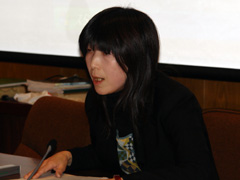
(1) Professor, Department of Art Education, Osaka University of Education
(2) East Asian Aesthetics
(3) Recent Publications:
2000 The Horizon of Calligraphic Art: Its History and Interpretation in China and Japan, Osaka University Press, pp.1-274. [in Japanese]
2004 Changes in Japanese 'Modern' Calligraphy, in Aesthetics: Looking at Japanese Culture11: 68-74.
|
|
15:15~15:45 |
質疑応答 |
|
15:45~16:15 |
休憩 |
 session 5:総合討論 session 5:総合討論
|
|
16:15~16:30 |
コメンテータ:座波圭美(財団法人ユネスコ・アジア文化センター教育協力係) |
|
|
ZAHA Tamami
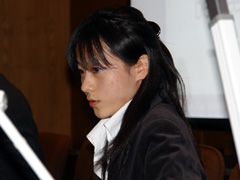 She is a Programme Assistant of the Education Division, the Asia/Pacific Cultural Centre for UNESCO (ACCU), whose major job responsibility is management of the Package Learning Materials on Environment (PLANET) project. She majored in International Education for her first and second degrees, especially focusing on literacy and Non-formal Education. Among her various activities such as internships with United Nations Children's Fund (UNICEF) Bhutan Office, Japan International Cooperation Agency (JICA) Ethiopia Office, and Dhaka Ahsania Mission (DAM, a local NGO in Bangladesh), her undergraduate dissertation based on her fieldwork in Akha villages in the Northern Thailand, focusing on education for hilltribes, addressed the issue of an educational dilemma they face in the majority Thai society.
|
|
16:30~17:15 |
総合コメンテータ:クリスチャン・ダニエルス(東京外国語大学アジア・アフリカ言語文化研究所・教授) |
|
|
Christian DANIELS

(1) Professor, Research Institute for Languages and Cultures of Asia and Africa, Tokyo University of Foreign Studies
(2) History of Chinese Technology, Ming/Qing
(3) Recent Publications:
Co-edited, 2003 Cultural Traditions and Technologies for Daily Life in Sichuan, Tokyo: Keiyusha. pp468. [in Japanese]
2002 The border between Southeast Asia and East Asia from the historical perspective of the Tai cultural sphere, in Nakami Tatsuo (ed.), Beyond the Borders: From the viewpoint of the peripheral areas of East Asia, Tokyo: Yamakawa Shuppansha, pp.137-189. [in Japanese]
|
|
17:15~17:55 |
総合討論 |
|
17:55~18:00 |
閉会挨拶 |

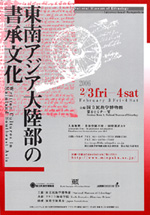
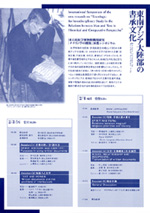
 招聘者
招聘者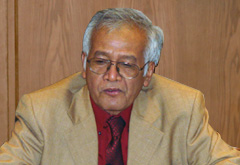 開会挨拶
開会挨拶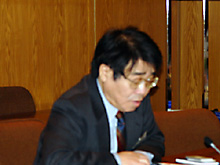 実行委員
実行委員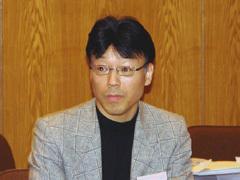 実行委員
実行委員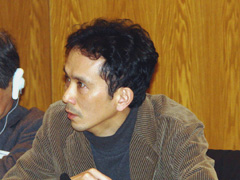

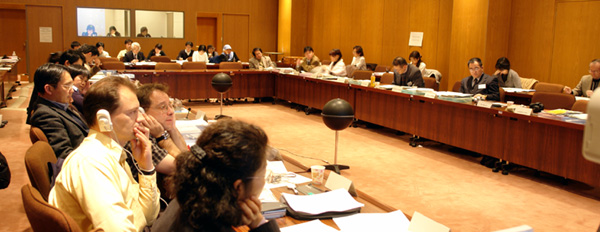

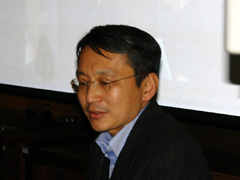
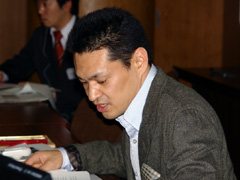 The Tai Dam are one of the Tai-speaking peoples living mainly in the valleys of Northwestern Vietnam. They are known as an ethnic group possessing their own traditional scripts derived from ancient Khmer scripts, even though they are not Theravada Buddhists. More than two thousand manuscripts have already been found or collected in the villages and the libraries of Vietnam, and have been classified as folk songs, literary works, annals, customary laws, divinations, written genealogies, and so on. Most of these manuscripts were written at the beginning of the 20th century when French colonial administrative control over Northwestern Vietnam was established.
The Tai Dam are one of the Tai-speaking peoples living mainly in the valleys of Northwestern Vietnam. They are known as an ethnic group possessing their own traditional scripts derived from ancient Khmer scripts, even though they are not Theravada Buddhists. More than two thousand manuscripts have already been found or collected in the villages and the libraries of Vietnam, and have been classified as folk songs, literary works, annals, customary laws, divinations, written genealogies, and so on. Most of these manuscripts were written at the beginning of the 20th century when French colonial administrative control over Northwestern Vietnam was established.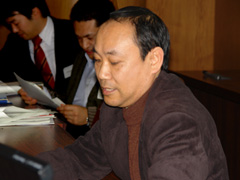 This paper focuses on historical expressions in the changing process of worshiping guardian spirits together by 3 Tai-Lue villages in Nan province, Northern Thailand. Their migration history has been remade based on the situation of rural development competition, especially N and D village.
This paper focuses on historical expressions in the changing process of worshiping guardian spirits together by 3 Tai-Lue villages in Nan province, Northern Thailand. Their migration history has been remade based on the situation of rural development competition, especially N and D village.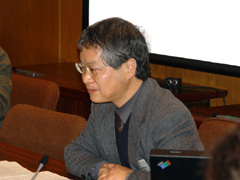
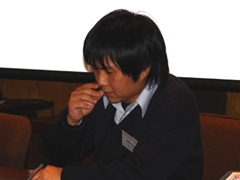 "Tham script" has been widely used in areas of four countries, namely Thai, Laos, China, Burma, where Tai speaking peoples inhabit. In this paper I examine how Tai script of Sipsongpanna Tai Autonomous State in China, a variation of Tham script, has been manipulated by different groups since Sipsongpanna was incorporated into People's Republic of China in 1950s. During the Cultural Revolution period, Tai script was prohibited to read and write but it was revived since China changed the cultural policy against minorities nationalities in the beginning of 1980s.
"Tham script" has been widely used in areas of four countries, namely Thai, Laos, China, Burma, where Tai speaking peoples inhabit. In this paper I examine how Tai script of Sipsongpanna Tai Autonomous State in China, a variation of Tham script, has been manipulated by different groups since Sipsongpanna was incorporated into People's Republic of China in 1950s. During the Cultural Revolution period, Tai script was prohibited to read and write but it was revived since China changed the cultural policy against minorities nationalities in the beginning of 1980s.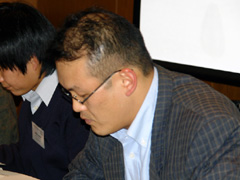 The Karen of Burma is a people who include, according to a recent study, more than forty linguistic subgroups, with Sgaw and Pwo as two major groups. Along with this linguistic diversity they have developed several distinct script systems such as Sgaw mission and Sgaw monastic scripts for Sgaw, Pwo mission, Pwo monastic, and Leke scripts for Pwo, and Pao script for Pao. Each seems to play a crucial part of the various Karen cultural movements of the present days. There is also an attempt by Sgaw and Pwo Christians to create a new script system applicable to both of the languages, and it clearly intends to revive their ethnic culture and to strengthen their social ties as Karen. These tendencies were, however, perhaps uncommon among the Karens in the colonial Burma.
The Karen of Burma is a people who include, according to a recent study, more than forty linguistic subgroups, with Sgaw and Pwo as two major groups. Along with this linguistic diversity they have developed several distinct script systems such as Sgaw mission and Sgaw monastic scripts for Sgaw, Pwo mission, Pwo monastic, and Leke scripts for Pwo, and Pao script for Pao. Each seems to play a crucial part of the various Karen cultural movements of the present days. There is also an attempt by Sgaw and Pwo Christians to create a new script system applicable to both of the languages, and it clearly intends to revive their ethnic culture and to strengthen their social ties as Karen. These tendencies were, however, perhaps uncommon among the Karens in the colonial Burma.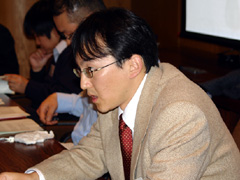 Lik Long, "The Great Books (Manuscripts)," are the Buddhist writings, which have been inherited among the Shan in a manuscript form (and in print in recent years) and recited for the audience in some Buddhist rites and festivals. Lik Long are also offered to Buddhist temples for merit making. From the 19th century until the early 20th century, some distinguished intellectuals appeared in Shan States and left many works, especially commentaries on Buddhist texts and instructive stories adapted from Jataka. These intellectuals are praised as Khu Mo Lik Tai, "Master of Shan Literature," and their works are esteemed as the essence of Shan literate culture. Most Lik Long that can be seen today are the work of these masters.
Lik Long, "The Great Books (Manuscripts)," are the Buddhist writings, which have been inherited among the Shan in a manuscript form (and in print in recent years) and recited for the audience in some Buddhist rites and festivals. Lik Long are also offered to Buddhist temples for merit making. From the 19th century until the early 20th century, some distinguished intellectuals appeared in Shan States and left many works, especially commentaries on Buddhist texts and instructive stories adapted from Jataka. These intellectuals are praised as Khu Mo Lik Tai, "Master of Shan Literature," and their works are esteemed as the essence of Shan literate culture. Most Lik Long that can be seen today are the work of these masters.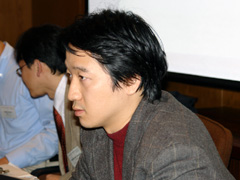
 This paper traces the diffusion of Lao scripts by taking stock of the oldest inscriptions found in Laos. Their different styles and methods of writing are analysed and compared to other Tai scripts. The results show that the appearance of scripts in Laos is closely related to the diffusion of Lan Na Culture and Buddhism. Now that there is a substantial inventory of lao inscriptions, it is possible to recognise the ways both secular and religious writings spread into the territory of the former Kingdom of Lan Xang, and to understand the processes that led to their actual formation.
This paper traces the diffusion of Lao scripts by taking stock of the oldest inscriptions found in Laos. Their different styles and methods of writing are analysed and compared to other Tai scripts. The results show that the appearance of scripts in Laos is closely related to the diffusion of Lan Na Culture and Buddhism. Now that there is a substantial inventory of lao inscriptions, it is possible to recognise the ways both secular and religious writings spread into the territory of the former Kingdom of Lan Xang, and to understand the processes that led to their actual formation. This presentation focuses on the modern use of palm leaf books, bailan, and Tham scripts in the rural life of the Northeastern Thailand, from an anthropological viewpoint. The studies of these old scripts, referred to as akson boran, were undertaken in Thailand in the fields of history or literature. However, most villagers use the palm leaves and old scripts merely as "tools," consciously or unconsciously misreading and misinterpreting their literal meanings. Therefore, I attempt to analyze the knowledge contained in the bailan and Tham scripts as a tool for understanding the bodiness and religious consciousness of the villagers. The usefulness of this knowledge is not limited to only the village intellectuals, such as the monks, but also in a general sense, to the villagers. This study aims to shed light on the knowledge surrounding bailan and Tham scripts, which is related to the bodiness and religious beliefs, in the various contexts of the village.
This presentation focuses on the modern use of palm leaf books, bailan, and Tham scripts in the rural life of the Northeastern Thailand, from an anthropological viewpoint. The studies of these old scripts, referred to as akson boran, were undertaken in Thailand in the fields of history or literature. However, most villagers use the palm leaves and old scripts merely as "tools," consciously or unconsciously misreading and misinterpreting their literal meanings. Therefore, I attempt to analyze the knowledge contained in the bailan and Tham scripts as a tool for understanding the bodiness and religious consciousness of the villagers. The usefulness of this knowledge is not limited to only the village intellectuals, such as the monks, but also in a general sense, to the villagers. This study aims to shed light on the knowledge surrounding bailan and Tham scripts, which is related to the bodiness and religious beliefs, in the various contexts of the village. My paper is a study of the cultural context of writing and literary scripts in traditional Lao literature. It examines how both intentionally and unintentionally the written medium has served to shape an audience's perception of both individual literary works and the very concept of literature itself. A major focus of this study is the investigation of the close relationship between the written medium of the literature and its status as a 'sacred Buddhist' and 'supernatural' tradition.
My paper is a study of the cultural context of writing and literary scripts in traditional Lao literature. It examines how both intentionally and unintentionally the written medium has served to shape an audience's perception of both individual literary works and the very concept of literature itself. A major focus of this study is the investigation of the close relationship between the written medium of the literature and its status as a 'sacred Buddhist' and 'supernatural' tradition.
 The Iu Mien society accepted the Chinese writing system and has since used the system for preparing its ritual and secular documents. The Iu Mien priests chant verses from their sacred book that is written in Chinese and also write their prayers in Chinese. In the past, contractual agreements between parties were also prepared in Chinese
The Iu Mien society accepted the Chinese writing system and has since used the system for preparing its ritual and secular documents. The Iu Mien priests chant verses from their sacred book that is written in Chinese and also write their prayers in Chinese. In the past, contractual agreements between parties were also prepared in Chinese The Raglai, Churu, and Hroi and most Malay speakers of the Montagnards [Vietnam's Central Highlanders] have the same language, folklore, culture, and pantheon with the Cham. The Raglai people don't really have a history of literature. In their tradition the Cham teach their writing under the master-pupil system through their Ahier and Awar specialist, religious, 'priest' groups. These privileged status groups monopolized the role of the religious specialist, the administrative officials, and the teachers and authors of literature within Cham society. One, and possibly the only way, to distinguish Cham villages from Raglai villages is the presence of these classes of people and literature. After the destruction of the Cham Kingdom in 1835 through a peoples revolt many of the Cham fled the coast to the interior, especially those of the status classes. Most common Cham people were illiterate, depending on the 'priest' classes to teach, interpret, and use the literature in ritual.
The Raglai, Churu, and Hroi and most Malay speakers of the Montagnards [Vietnam's Central Highlanders] have the same language, folklore, culture, and pantheon with the Cham. The Raglai people don't really have a history of literature. In their tradition the Cham teach their writing under the master-pupil system through their Ahier and Awar specialist, religious, 'priest' groups. These privileged status groups monopolized the role of the religious specialist, the administrative officials, and the teachers and authors of literature within Cham society. One, and possibly the only way, to distinguish Cham villages from Raglai villages is the presence of these classes of people and literature. After the destruction of the Cham Kingdom in 1835 through a peoples revolt many of the Cham fled the coast to the interior, especially those of the status classes. Most common Cham people were illiterate, depending on the 'priest' classes to teach, interpret, and use the literature in ritual.
 She is a Programme Assistant of the Education Division, the Asia/Pacific Cultural Centre for UNESCO (ACCU), whose major job responsibility is management of the Package Learning Materials on Environment (PLANET) project. She majored in International Education for her first and second degrees, especially focusing on literacy and Non-formal Education. Among her various activities such as internships with United Nations Children's Fund (UNICEF) Bhutan Office, Japan International Cooperation Agency (JICA) Ethiopia Office, and Dhaka Ahsania Mission (DAM, a local NGO in Bangladesh), her undergraduate dissertation based on her fieldwork in Akha villages in the Northern Thailand, focusing on education for hilltribes, addressed the issue of an educational dilemma they face in the majority Thai society.
She is a Programme Assistant of the Education Division, the Asia/Pacific Cultural Centre for UNESCO (ACCU), whose major job responsibility is management of the Package Learning Materials on Environment (PLANET) project. She majored in International Education for her first and second degrees, especially focusing on literacy and Non-formal Education. Among her various activities such as internships with United Nations Children's Fund (UNICEF) Bhutan Office, Japan International Cooperation Agency (JICA) Ethiopia Office, and Dhaka Ahsania Mission (DAM, a local NGO in Bangladesh), her undergraduate dissertation based on her fieldwork in Akha villages in the Northern Thailand, focusing on education for hilltribes, addressed the issue of an educational dilemma they face in the majority Thai society.